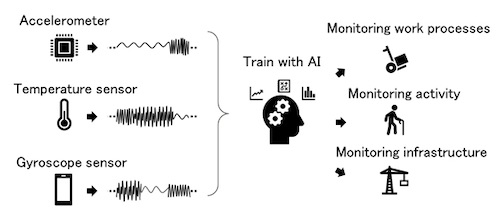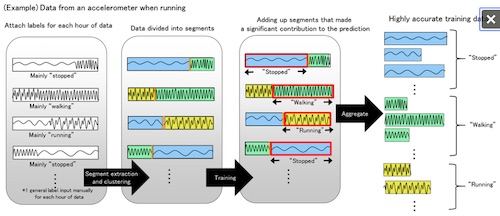|
Fujitsu Develops Automatic Labeling Technology to Accelerate AI Use of Time-Series Data
Expected to see application in monitoring for people and machines using smartphones and equipment sensors
TOKYO, May 10, 2019 - (JCN Newswire) - Fujitsu Laboratories Ltd. and Kumamoto University has announced the development of technology to easily create the training data necessary to apply AI to time-series data, such as those from accelerometers and gyroscopic sensors.
 | | Figure 1: Examples of AI monitoring using time-series data |
 | | Figure 2: Diagram of the newly developed technology |
Time-series data obtained from sensors does not include anything other than every-changing numerical data. Therefore, in order to create training data for use in machine learning, it was necessary to manually attach finely detailed labels to the data in accordance to its changing values, indicating what was done and when at each point where the numerical values changed. For this reason, huge numbers of man-hours were required, and the use of AI with time-series data had seen limited progress.
Now, Fujitsu Laboratories and Kumamoto University have enabled the automatic creation of highly accurate training data with appropriate labels for each action, just by manually attaching a single label to each longer time period, even if they include multiple actions, indicating the major action in that time period according to human judgement. Because this significantly reduces the number of man-hours required, this technology will accelerate the use of AI with time-series data. The new development is expected to enable easier installation of services such as fall detection, operational functionality checks, and abnormality detection for machines, in smartphones and various other devices.
Development Background
In recent years, with the evolution of technology such as the Internet of Things (IoT), it has become possible to obtain a large amount time-series data from a variety of sensors. For example, by developing a functionality in which AI can determine the meaning of the motions of people and objects from the characteristics captured by accelerometers, it is expected that advanced functionality for monitoring people and machines can be incorporated into smartphones and various equipment. In order to apply AI to this sort of time-series data, it is necessary to create training data to train AI.
http://www.acnnewswire.com/topimg/Low_FujitsuAIFig151019.jpg
Figure 1: Examples of AI monitoring using time-series data
Issues
Time-series data obtained from sensors consists of just numbers recording values from the sensors moment by moment, so it is necessary to attach meaning to the data indicating "what" (labels) and "when" (segments) in creating training data for AI. For example, data from accelerometers when a person goes running includes intermingled data from when a person is running, when they are walking, and when they are standing still. So in order to create training data for AI, the data needs to be separated into segments, and labeled as "Running" "Walking" and "Stopped."
Conventionally, to create this sort of training data, the typical process was to record a video of the behavior while measuring the time-series data, identify the type of behavior seen with the changes in the numerical values at a second-by-second level, and manually attaching the labels. Because this process required a significant amount of work and time, the application of AI to time-series data saw limited progress, and there was a demand for a technology to automate the labeling process and reduce the workload.
About the Newly Developed Technology
Now, Fujitsu Laboratories and Kumamoto University have developed a technology that can automatically create highly accurate training data that enables the use of AI with time-series data, just by inputting a label expressing the main action underway over a longer time segment (for example, one hour). The features of this newly developed technology are as follows.
1. Extracting appropriate segments
Looking at time-series data, this technology can learn characteristics of times when the same activity is ongoing and characteristics of times when the activity changes, and can then automatically extract appropriate time periods from time-series data with actions based on same characteristics(1).
2. Highly accurate labeling
With this technology, users attach a single broad label for long segments of data (for example, one hour), such as "running" if the majority of the segment is spent running. After a deep neural network is trained to predict such labels and the resulting estimated labels can be used to calculate the segment of the time-series data that most contributed to that prediction. Also by adding up the time periods that have a high degree of contribution as label candidates, this system can create training data capable of accurate prediction.
http://www.acnnewswire.com/topimg/Low_FujitsuAIFig251019.jpg
Figure 2: Diagram of the newly developed technology
Effects
Fujitsu Laboratories and Kumamoto University conducted a trial where they attached labels to time-series data from accelerometers while performing mock work processes in a factory such as polishing. As a result, they confirmed that this technology was able to correctly label 92% of time periods. They judged that this was equivalent to the highly accurate results obtained when using data that was manually labelled in detail as training data. With this technology, one can easily create training data for AI use from time-series data, and further development is expected for the functionality that uses AI to determine activities captured by sensors. In addition, because this technology makes determinations based on just the numerical characteristics of time-series data, and does not rely on the type of sensor, it could also be applied to time-series data obtained from devices such as temperature sensors and pulse wave sensors.
Future Plans
Fujitsu Laboratories and Kumamoto University aim to conduct field trials using time-series data from a variety of fields, with the goal of commercializing this technology as a preprocessing technology for time-series data as part of Fujitsu Human Centric AI Zinrai, Fujitsu Limited's AI technology, during fiscal 2019.
(1) Automatically extract appropriate time periods with actions based on same characteristics from time-series data Using technology from Kumamoto University.
About Fujitsu Laboratories
Founded in 1968 as a wholly owned subsidiary of Fujitsu Limited, Fujitsu Laboratories Ltd. is one of the premier research centers in the world. With a global network of laboratories in Japan, China, the United States and Europe, the organization conducts a wide range of basic and applied research in the areas of Next-generation Services, Computer Servers, Networks, Electronic Devices and Advanced Materials. For more information, please see: http://www.fujitsu.com/jp/group/labs/en/.
Contact:Fujitsu Laboratories Ltd.
Artificial Intelligence Laboratory
E-mail: time-series-labeling@ml.labs.fujitsu.com
Fujitsu Limited
Public and Investor Relations
Tel: +81-3-3215-5259
URL: www.fujitsu.com/global/news/contacts/
Source: Fujitsu Ltd
Sectors: Electronics, Enterprise IT
Copyright ©2025 JCN Newswire. All rights reserved. A division of Japan Corporate News Network. |
Latest Release

Avantor Appoints Gladys Wang as Vice President, Bioprocessing Commercial, Asia, Middle East & Africa
Dec 24, 2025 13:20 JST
| 
Tohoku University and Fujitsu utilize Causal AI to discover superconductivity mechanism of promising new functional material
Dec 23, 2025 14:58 JST
| 
Toward an Athlete- and Planet-Friendly Hakone Ekiden: All Vehicles Provided for the 2026 Race Will Be Electrified
Dec 23, 2025 03:18 JST
| 
MHI Group to Accelerate Development of Digital Talent
Dec 23, 2025 02:57 JST
| 
MHI and EXEO Group Build and Begin Commercial Use of Japan's First GPU Servers with Two-Phase DLC
Dec 23, 2025 02:20 JST
| 
MHI Participates in Demonstration Testing of Vehicle-Infrastructure Integration System for Autonomous Buses in Shimotsuke City
Dec 19, 2025 03:24 JST
| 
NEC and emaratech Collaborate on Biometric Smart Gates Supporting UAE Airport Operations
Dec 19, 2025 03:06 JST
| 
Fujitsu to showcase mobility and physical AI tech at CES 2026
Dec 19, 2025 02:42 JST
| 
Kirin and Fujitsu elucidate a novel gut-brain axis mechanism of citicoline for the first time worldwide through AI-based analysis and experimental validation leveraging drug discovery DX technology
Dec 19, 2025 02:06 JST
| 
TANAKA PRECIOUS METAL GROUP and TANAKA MIRAI Lab. Released Their Fourth Collaborative Musical Work with Sound Wellness Lab (Della): "Precious Metal Orchestra - A Musical Voyage through the Sound of Precious Metals for Christmas" now available for streaming.
Dec 18, 2025 22:00 JST
| 
SAKENOVA: 28-Year-Old Master Brewer Pioneers AI-Driven Sake Revolution, Achieving 40% Cost Reduction While Winning International Gold Medals
Dec 15, 2025 23:00 JST
| 
NEC Provides Vehicle Management Equipment for Autonomous Driving at Tokyo International Airport
Dec 15, 2025 19:41 JST
| 
NEC and AEROTHAI Elevate Air Traffic Safety with Advanced Time Sync Solutions from Adtran Oscilloquartz
Dec 15, 2025 19:04 JST
| 
Olympus Triples Venture Capital Fund Investment to Strengthen MedTech Leadership
Dec 15, 2025 08:30 JST
| 
HKTDC 4Q25 Export Confidence Index: 2026 Hong Kong Export Growth of 8-9%, Sustained AI product demand lays solid foundation for future expansion
Dec 12, 2025 23:15 JST
| 
Honda to Launch New Heritage Service Business
Dec 12, 2025 20:31 JST
| 
Bank Mandiri Enhances Digital Resiliency for Financial Trading in Indonesia through Advanced Time Sync Solutions with NEC and Adtran Oscilloquartz
Dec 12, 2025 19:59 JST
| 
NEC and ClimateAi sign a Memorandum of Understanding (MoU) for business co-creation to enhance climate resilience across various industries
Dec 12, 2025 18:13 JST
| 
Anime Tokyo Station: A Series of Linked Events to Be Held in Conjunction with the Anniversary Joint Exhibition
Dec 12, 2025 11:00 JST
| 
Eisai Rated "A", the Highest Rating by CDP in Both Climate Change and Water Security Categories for the Second Consecutive Year
Dec 11, 2025 19:41 JST
|
More Latest Release >>
|